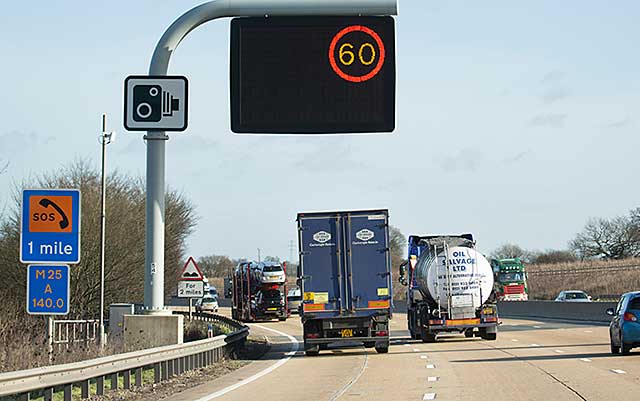
Since first being implemented in 2006, smart motorways have been the subject of many debates – mostly centring around whether they're safe enough. We're here to help drivers understand smart motorways and how to stay safe while driving on them. Find answers to all your questions below, including what the difference is between a regular motorway and a smart motorway.
|
On this page: |
What's a smart motorway?
A smart motorway is a section of motorway that uses traffic management methods to increase capacity and reduce congestion in particularly busy areas.
There are 3 types of smart motorway: controlled, dynamic hard shoulder, and all-lane running (ALR).
When were smart motorways introduced?
They were first introduced by The Highways Agency (now known as National Highways) in 2006, with the M42 being the first dynamic hard shoulder motorway. However, the first controlled motorway was introduced in 1995 on the M25. Smart motorways are different to normal motorways, which have a fixed speed limit of 70mph (unless there are roadworks or there's an incident) and a permanent hard shoulder.
What's the difference between smart motorways and other motorways?
The difference with smart motorways is that they use:
- CCTV, radar and sensors to keep an eye on traffic
- Speed restrictions and lanes closures if there’s an incident or congestion
- Traffic calming measures like variable speed limits (of 40, 50 or 60mph), Red 'X' lanes or driving on the hard shoulder
- Overhead signs and large roadside information signs to warn you about queues, speed limits, closed lanes and diversions
| Back to top |
What are the different types of smart motorway?
There are 3 different types of smart motorway: controlled, dynamic hard shoulder, and all-lane running. Each works in a slightly different way.
1. Controlled motorway
These have 3 or more lanes, variable speed limits and a hard shoulder for emergency use only. They're sometimes known as managed motorways.
An example of this type of motorway is the western section of the M25.
2. Dynamic hard shoulder
These have variable speed limits and a hard shoulder that can be opened up to traffic at busy times. Overhead signs tell you when you can drive on the hard shoulder.
These motorways have a solid line marking the left-most lane, and feature emergency areas.
Examples of this type of motorway are the M42 at J3a-J7, the M4 at J19-20, and the M5 at J15-17.
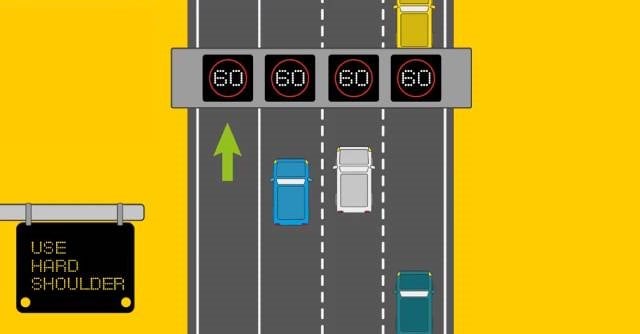
3. All-lane running
These motorways have variable speed limits, no hard shoulder, and emergency areas approximately every 2.5km or 1.6km. Overhead signs will show a Red 'X' if you can't use a particular lane. All existing ALR motorways also feature stopped vehicle detection technology.
These type of motorways have a dotted line marking the left-most lane.
Examples of this type of motorway are the the M25 at J23-27 and at J5-6.
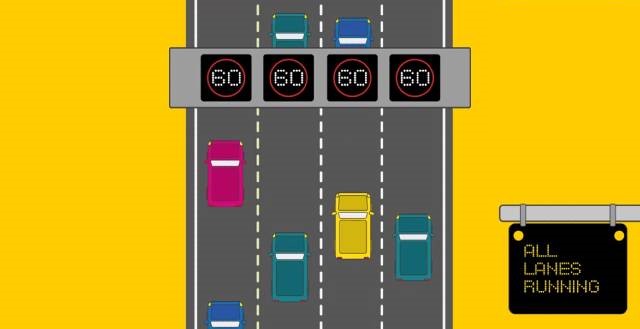
| Back to top |
What's the aim of a smart motorway?
The aim of smart motorways is to provide increased capacity on congested sections of motorways, enabling reduced and more reliable journey times.
- Variable speed limits can help to manage jams and rush hour traffic
- Red 'X' lanes can tell drivers when lanes are closed due to accidents, debris, breakdowns, roadworks and more
- Some types of motorways open up the hard shoulder as an extra lane
Why have some hard shoulders been removed?
The aim of dynamic hard shoulder and all lane running motorways is to reduce congestion without big costs and miles of roadworks. That's because opening up the hard shoulder as an extra lane is cheaper and less disruptive than widening the road.
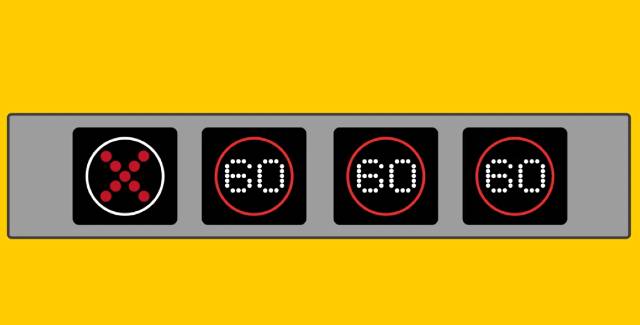
| Back to top |
Which UK motorways are smart?
The M42 was the first smart motorway to use active traffic management. But there's now more than 500 miles of smart motorway in the UK, including many without hard shoulders.
Which motorways don't have a hard shoulder?
Sections of these motorways are all-lane running (with no hard shoulder) or are under construction:
- M1 - J16-13, J19-16, J24-25, J28-35a, J39-42
- M3 - J2-4a
- M4 - J3-12
- M5 - J4a-6
- M6 - J10a-13, J16-19, J13-15, J2-4
- M20 - J3-5
- M23 - J8-10
- M25 - J5-6/7, J23-27
- M27 - J4-11
- M62 - J18-20, J10-12, J25-26
National Highways has a map of all the smart motorways in England which you can find on the gov.uk website.
| Back to top |
Do smart motorways have hard shoulders?
Many smart motorways don't have a hard shoulder or only have a hard shoulder at certain times:
- All-lane running motorways don't have a permanent hard shoulder. Instead, the hard shoulder is permanently converted to a running lane, with emergency areas at regular intervals. If a car breaks down here, the lane can be closed with a Red 'X' sign.
- Dynamic hard shoulder motorways have a temporary hard shoulder. It's used as a hard shoulder when it's quiet but can be opened up to drivers to ease traffic at busy times. Dynamic hard shoulder motorways also feature emergency areas.
- Controlled motorways have a permanent hard shoulder which works the same way as a normal motorway hard shoulder.
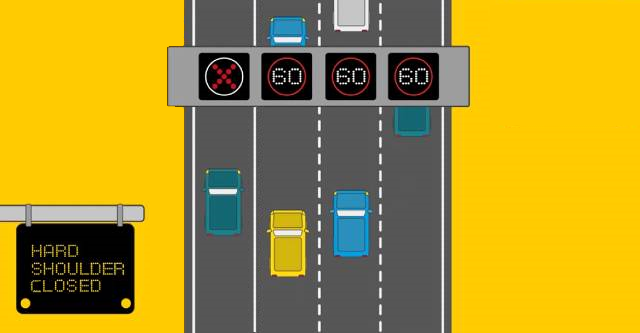
| Back to top |
What is an emergency area?
All-lane running and dynamic hard shoulder smart motorways feature emergency areas. They are orange, set back from live traffic lanes and have an emergency phone which connects directly to our control room so help can be arranged. These are spaced regularly on a motorway with no hard shoulder and are marked with blue signs featuring an orange SOS telephone symbol.
Emergency areas are for when a driver has no alternative but to stop and it has not been possible to leave the motorway or reach a motorway service area. Other places to stop in an emergency include sections of remaining hard shoulder, such as on slip roads at junctions.
How frequent are emergency areas?
The maximum distance between emergency areas is one mile. On newer smart motorways, the spacing between emergency areas has been reduced to 3/4 of a mile where possible (with a one-mile gap between these 'places of relative safety' at the most).
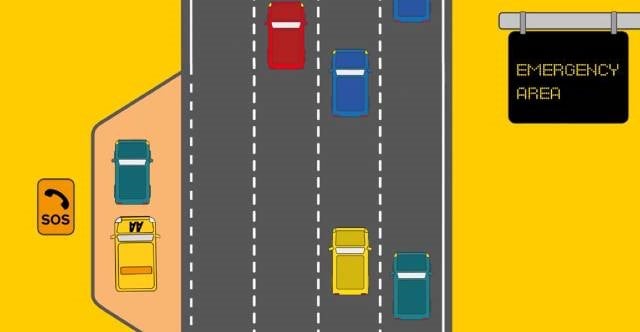
| Back to top |
How do I use an emergency area?
If you have to stop in an emergency area, follow these steps:
- Use the emergency SOS phone to contact the Regional Control Centre
- Let them know you've broken down so operators can monitor your vehicle by CCTV
- They'll contact us and we'll send out a mechanic or recovery truck to you as a priority
- Wait behind the safety barrier well away from traffic until the AA van arrives
- Once your vehicle's fixed, we'll contact the Regional Control Centre on the SOS phone before leaving
How do I rejoin the motorway?
Emergency areas are only short lay-bys and they're not designed for unassisted exits. Without assistance, they're not long enough to build up speed before re-joining the motorway.
Do not exit an emergency area without speaking to National Highways first. Use the free emergency telephone at the emergency area, which connects directly to National Highways' control room and identifies your location. They'll give you advice based on your circumstances and can help arrange further assistance for you (either by helping you to safely re-join the motorway by temporarily closing lane one or by sending a traffic officer patrol to help).
| Back to top |
What do I do if I break down on a smart motorway?
If you break down on a smart motorway, it's best to follow National Highways' advice. Stay calm and try to exit the motorway at the next junction or service area.
If you aren't able to get off the motorway, pull over into the hard shoulder if there is one. If there's no hard shoulder, aim for an emergency area (remember, there will always be at least one emergency area every mile on smart motorways). Follow the steps below in the event of a breakdown:
- Put your left indicators on
- Move into the left lane
- Enter the next emergency area, or the hard shoulder
- Put your hazard lights on
- Get behind a safety barrier where there is one. Keep well away from moving traffic
- Call National Highways on 0300 123 5000, then a breakdown provider for help
If you break down in a live lane, you'll need to call 999 straight away so they can close the lane you're in. In this case, stay in your vehicle with your seat belt on and all your lights on.
| Back to top |
What is a Red 'X' lane?
Smart motorways show a Red 'X' signal in the overhead gantry to control traffic and indicate that the lane's closed.
National Highways have upgraded CCTV cameras along smart motorways, allowing the police to enforce Red 'X' signals. Police forces are now actively using the cameras and drivers can receive three points plus a £100 fine if found to be ignoring the signage. This further increases the safety of drivers, their passengers, road workers and emergency services.Why a Red 'X' might show and what to do
A Red 'X' could mean that someone's broken down in that lane, there are workmen in the lane or there's another obstruction. You must move out the lane if you see a Red 'X' over it when you're driving. Don't go back into the lane until you see either a National Speed Limit symbol, an 'END' symbol, or a new speed limit is displayed.
National Highways has advice in this video on what to do when you see a lane with a Red 'X'.
Tips for driving on smart motorways
Our best advice for driving on a smart motorway would be to:
- Make sure your car is in good shape and has enough fuel before joining a smart motorway. If you break down or run out of fuel, you'll need to try and find an emergency area. The hard shoulder doesn't always act as a traditional hard shoulder on smart motorways, it may instead be a live traffic lane. This means breakdowns in live lanes can happen, causing a huge problem for traffic.
- Pay attention to the live-updating signs above the lanes. Speed limits can change based on the conditions or sometimes a Red 'X' can appear above certain lanes (usually for roadworks or to control the flow of traffic).
- If there's congestion, use the hard shoulder (as long as signage tells you it's ok to drive in the leftmost lane). Driving on what would normally be a hard shoulder can take some getting used to, but by doing so you'll help improve traffic flow.
| Back to top |
FAQs
What is the latest news on smart motorways?
You can find all the latest news on smart motorways here.
What are the rules on a smart motorway?
- Always pay attention to the electronic signs above each lane. They'll show you which lanes are open and the speed limit you need to follow
- Never drive in a lane that has a Red 'X' displayed above it
- If you break down in an all-lane running smart motorway, turn on your hazard lights and exit the motorway as soon as possible, or pull into an emergency area
Where will I see the Red cross (X) symbol?
You will most commonly see a red cross symbol above the leftmost lane, meaning that the hard shoulder can be used for breakdowns. However, smart motorways can display a Red X above any lane depending on the circumstances.
How do smart motorways detect a stationary vehicle?
There are radar units at the side of smart motorways that can track the flow of traffic in both directions and detect whether a vehicle has come to a full stop. If detected, these radar units automatically alert a smart motorway control room employee who can change signage above the lanes to indicate a breakdown and send for help.
Do smart motorways have speed cameras?
Yes, smart motorways have speed cameras, often featuring more of them than normal motorways. This is to ensure that drivers are adhering to the variable speed limits. When there’s no speed limit given by signage, the national speed limit is still in effect, so anyone driving above that limit will also be picked up by cameras.
What’s being done to make smart motorways safer?
Smart motorways are being retrofitted with radar units (Stationary Vehicle Detection systems). All smart motorways are to have these fitted by the end of 2023. Though this will lead to an increase in safety, the radar systems still aren’t 100% foolproof.
What is meant by smart motorways?
A smart motorway is a section of motorway that uses digital traffic management systems (such as live-updating electric signs above lanes) to manage congestion and the flow of vehicles. The hard shoulder is occasionally used as a live lane for traffic. The signs can show variable speed limits and direct traffic to specific lanes based on conditions.
Published: 22 December 2016 | Updated: 11 May 2023 | Author: The AA
